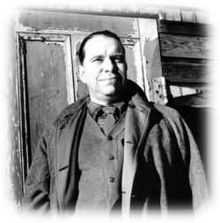Stuart Davis (painter)
| Stuart Davis | |
|---|---|
 Davis, 1940 | |
| Born |
December 7, 1892 Philadelphia |
| Died | June 24, 1964 (aged 71) |
| Nationality | American |
| Field | Painting, Modernism |
| Movement | American modernism |
Stuart Davis (December 7, 1892 – June 24, 1964), was an early American modernist painter. He was well known for his jazz-influenced, proto pop art paintings of the 1940s and 1950s, bold, brash, and colorful, as well as his ashcan pictures in the early years of the 20th century.
Childhood and training

He was born in Philadelphia to Edward Wyatt Davis and Helen Stuart Davis. His parents both worked in the arts. His father was the art editor of the Philadelphia Press while his mother was a sculptor. From 1909 to 1912, Davis studied painting under Robert Henri, the leader of the early modern art group the Eight.[1] Among his ashcan paintings is Chinatown (1912), set in Lower Manhattan. A black cat in the picture represents a promiscuous woman who is depicted nearby dressed in black and standing next to trash cans in a seedy neighborhood.[2]
In 1913, Davis was one of the youngest painters to exhibit in the controversial Armory Show, where he displayed five watercolors.[3]
Career
Exposed at this exhibition to the work of such artists as Vincent van Gogh, Henri Matisse, and Pablo Picasso, Davis became a committed "modern" artist and a major exponent of cubism and modernism in America.[3] He spent summers painting in Gloucester, Massachusetts, and made painting trips to Havana in 1918 and New Mexico in 1923.[3]
In the 1920s he developed his mature style of Hard-edge paintings, mainly abstract still lifes and landscapes; his use of contemporary subject matter such as cigarette packages, spark plug advertisements and the contemporary American landscape make him a proto-Pop artist.[4]
In 1928, he visited Paris, where he painted street scenes. In the 1930s, he became increasingly politically engaged; according to Cécile Whiting, Davis' goal was to "reconcile abstract art with Marxism and modern industrial society".[3] In 1934 he joined the Artists' Union; he was later elected its President.[3] In 1936 the American Artists' Congress elected him National Secretary. He painted murals for Federal Arts Project of the Works Progress Administration which are influenced by his love of jazz.[3]
He was represented by Edith Gregor Halpert at the Downtown Gallery in New York City.
Davis died of a stroke in New York on June 24, 1964, aged 71.
Public collections
Among the public collections holding work by Stuart Davis are:
Selected works
-

Garage No. 1, 1917, Hirshhorn Museum and Sculpture Garden, Washington, DC.
-

Tree and Urn, 1921, 30 x 19 inches
-

Lucky Strike, 1921, Museum of Modern Art, New York City
-

Steeple and Street, 1922, Hirshhorn Museum and Sculpture Garden, Washington, DC.
-

The Mellow Pad - Brooklyn Museum - 1945-1951
See also
- Precisionism
- The Masses
- Liberator (magazine)
- New Masses
References and sources
- References
- ↑ Cooper, Philip. Cubism. London: Phaidon, 1995, p. 120. ISBN 0714832502
- ↑ Exhibit at the Amon Carter Museum in Fort Worth, Texas
- ↑ 3.0 3.1 3.2 3.3 3.4 3.5 Cécile Whiting, "Stuart Davis", Oxford Art Online
- ↑ http://www.jasonkaufman.com/articles/stuart_davis_american_modernist.htm accessed online July 12, 2007
- Sources
- 2007 - Stuart Davis: A Catalogue Raisonné (3 volumes) by William Agee (Editor), Karen Wilkin, (Editor), Ani Boyajian, Mark Rutkoski (ISBN 0-300-10981-4)
- Karen Wilkin 1999 - Stuart Davis in Gloucester (ISBN 1-889097-34-9)
- Lowery Stokes Sims et al., Stuart Davis: American Painter, 333 pages, 129 color illus., The Metropolitan Museum of Art and Harry N. Abrams, Inc. 1991.
External links
| Wikimedia Commons has media related to Stuart Davis (painter). |
- Stuart Davis Artwork Examples on AskART.
- Stuart Davis Artwork Examples on ibiblio's WebMuseum.
- Comrades in Art: Stuart Davis